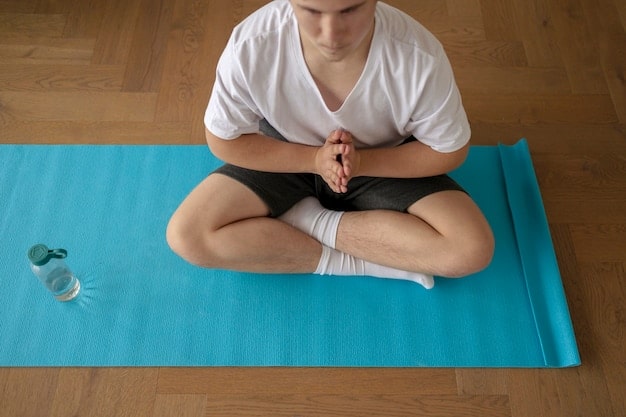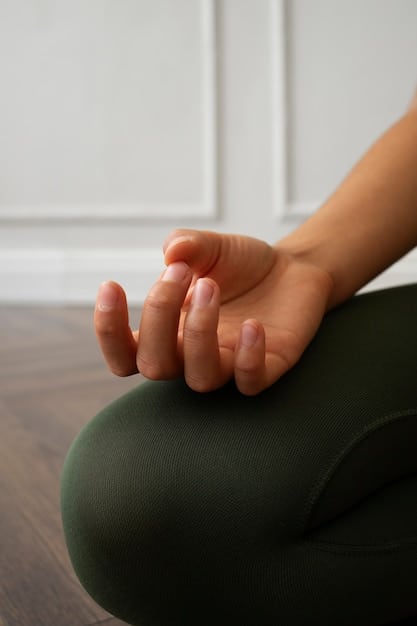Yoga & Mindfulness: Your Guide to Inner Peace Through Movement

Yoga and mindfulness provide a holistic approach to cultivating inner peace, integrating physical postures, breathwork, and meditation techniques to reduce stress, enhance self-awareness, and promote overall well-being.
Discover the power of Yoga and Mindfulness: A Step-by-Step Guide to Cultivating Inner Peace Through Movement. This guide will walk you through simple yet effective practices to help you find calmness and balance in your daily life.
Understanding Yoga and Mindfulness
Yoga and mindfulness are powerful tools that can transform your mental and physical well-being. By combining these two practices, you can achieve a deeper sense of inner peace and balance.
Let’s explore what yoga and mindfulness entail and why they are so effective when practiced together.
What is Yoga?
Yoga is an ancient practice that originated in India. It involves physical postures (asanas), breathing techniques (pranayama), and meditation to promote physical and mental health. Yoga aims to unite the mind, body, and spirit.
What is Mindfulness?
Mindfulness is the practice of being present in the moment, without judgment. It involves paying attention to your thoughts, feelings, and sensations as they arise, allowing you to observe them without getting carried away.

Together, yoga and mindfulness create a synergistic effect. Yoga helps to calm the body and prepare it for mindful practices, while mindfulness enhances the benefits of yoga by promoting awareness and presence during each movement and breath.
Here are some key benefits of combining yoga and mindfulness:
- Reduced stress and anxiety
- Improved focus and concentration
- Enhanced self-awareness
- Increased emotional regulation
- Promotion of overall well-being
Understanding the basics of yoga and mindfulness sets the stage for a deeper dive into how to integrate these practices into your daily life.
Preparing for Your Yoga and Mindfulness Practice
Before you begin your yoga and mindfulness journey, it’s essential to create a conducive environment and set the right intentions. Proper preparation can significantly enhance your experience and make it more effective.
Here are some steps to prepare for your practice:
Creating a Peaceful Environment
Choose a quiet and comfortable space where you can practice without distractions. This could be a corner of your bedroom, a garden, or any place where you feel at peace. Make sure the area is clean, tidy, and well-ventilated.
Gathering Your Supplies
Ensure you have the necessary supplies to support your practice. A yoga mat is essential for providing cushioning and stability during postures. You might also want to have:
- Blocks to assist with challenging poses
- A blanket for added comfort and support
- A cushion for meditation
- Comfortable clothing that allows for free movement
Setting Your Intentions
Before you start, take a few moments to set an intention for your practice. What do you hope to achieve? Do you want to reduce stress, improve focus, or cultivate a sense of gratitude? Setting an intention can help you stay grounded and focused during your session. For example, you might tell yourself: “Today, I will practice with patience and compassion towards myself.”
Mindful Breathing Before Starting
Begin with a few minutes of mindful breathing to center yourself. Sit comfortably and close your eyes. Focus on your breath as it enters and leaves your body. Notice the rise and fall of your chest or abdomen. If your mind wanders, gently bring your attention back to your breath.

Proper preparation is the foundation for a successful yoga and mindfulness practice. By creating a peaceful environment, gathering your supplies, setting intentions, and practicing mindful breathing, you set yourself up for a truly transformative experience.
Basic Yoga Poses for Beginners
For beginners, it’s a great idea to start with some basic yoga poses. These poses are gentle and accessible, helping you build strength, flexibility, and body awareness. Remember to listen to your body and modify poses as needed.
Here are a few fundamental yoga poses perfect for beginners:
Mountain Pose (Tadasana)
Stand tall with your feet hip-width apart. Ground down through your feet, engage your thigh muscles, and draw your tailbone slightly down. Lift your chest, roll your shoulders back, and extend your arms down by your sides. Imagine a string pulling you up from the crown of your head. Breathe deeply and hold for several breaths.
Downward-Facing Dog (Adho Mukha Svanasana)
Start on your hands and knees. Place your hands shoulder-width apart and your knees hip-width apart. Tuck your toes under and lift your hips up and back, forming an inverted V-shape. Distribute your weight evenly between your hands and feet. Lengthen your spine and relax your head and neck. Hold for several breaths.
Child’s Pose (Balasana)
Start on your hands and knees. Bring your big toes together and sit back on your heels. Separate your knees slightly wider than your hips. Exhale and lower your torso between your knees. Extend your arms forward, palms down, or rest them alongside your body, palms up. Relax your forehead on the mat. Breathe deeply and hold for several breaths.
Warrior I (Virabhadrasana I)
Begin in Mountain Pose (Tadasana). Step your left foot back about 3-4 feet. Turn your left foot out 45 degrees. Bend your right knee over your right ankle, keeping your knee aligned with your ankle. Extend your arms overhead, palms facing each other or slightly apart. Gaze forward or slightly up. Hold for several breaths, then repeat on the other side.
Integrating these poses into your routine not only enhances physical flexibility and strength but also promotes mental clarity and emotional balance. Regular practice of these poses helps calm the nervous system and foster a deeper mind-body connection.
Mindfulness Techniques to Enhance Your Practice
Mindfulness techniques can significantly enhance your yoga practice by bringing greater awareness and presence to each movement and breath. By practicing mindfulness, you can reduce distractions, increase focus, and deepen your connection with your body.
Here are some mindfulness techniques to integrate into your yoga practice:
Breath Awareness
Throughout your yoga practice, pay attention to your breath. Notice the sensation of the air entering and leaving your body. Observe the rise and fall of your chest or abdomen. If your mind wanders, gently bring your attention back to your breath. Mindful breathing calms the nervous system and enhances relaxation.
Body Scan Meditation
Before or after your yoga practice, try a body scan meditation. Lie on your back with your eyes closed. Bring your attention to your toes and notice any sensations you feel. Gradually move your attention up your body, focusing on each body part—feet, ankles, calves, knees, thighs, hips, abdomen, chest, arms, hands, neck, and head. Observe any sensations without judgment.
Mindful Movement
During your yoga poses, focus on the sensations in your body. Notice the stretch in your muscles, the weight on your joints, and the contact of your body with the mat. Move slowly and deliberately, paying attention to each movement. Avoid rushing through the poses. Mindful movement cultivates body awareness and reduces the risk of injury.
By incorporating mindfulness techniques into yoga, you not only improve your physical well-being, but also foster a stronger and more profound mind-body connection. These techniques teach you to be present, aware, and non-judgmental, which are essential for cultivating inner peace and reducing stress.
Creating a Daily Yoga and Mindfulness Routine
Establishing a daily yoga and mindfulness routine can provide consistent benefits for your mental and physical health. Consistency is key to experiencing the long-term effects of these practices.
Here are some tips for creating a daily routine:
Start Small
Begin with a short practice, such as 10-15 minutes per day. As you become more comfortable, you can gradually increase the duration. Even a few minutes of yoga and mindfulness can make a difference in your day.
Choose a Convenient Time
Select a time that works best for your schedule. For many people, practicing in the morning is a great way to start the day with calmness and intention. Others prefer to practice in the evening to unwind before bed.
Be Consistent
Try to practice at the same time each day to establish a routine. Consistency helps you build a habit and makes it easier to stick with your practice over time.
Listen to Your Body
Pay attention to your body’s needs and adjust your practice accordingly. Some days you may feel energized and able to do more challenging poses. Other days you may need to modify poses or focus on gentle stretches and relaxation.
Creating a daily yoga and mindfulness routine can be transformative, offering not only physical benefits but also promoting emotional resilience and mental clarity. Tailor your practice to fit your life, and enjoy the journey towards a more balanced and peaceful you.
Overcoming Challenges and Staying Motivated
Like any practice, you will encounter challenges along the way. Staying motivated and overcoming obstacles is crucial to maintaining a consistent yoga and mindfulness routine.
Here are some common challenges and how to overcome them:
Lack of Time
If you’re struggling to find time for yoga and mindfulness, try breaking your practice into smaller segments. Even 5-10 minutes of mindful breathing or a few yoga poses throughout the day can be beneficial. Remember, something is always better than nothing.
Distractions
If you find yourself easily distracted during your practice, try practicing in a quiet space and minimizing interruptions. Turn off your phone, close the door, and let your family or housemates know you need some uninterrupted time. Alternatively, you can use guided meditation or yoga videos to help you stay focused.
Lack of Motivation
If you’re feeling unmotivated, try setting small, achievable goals. Instead of aiming for a long practice every day, commit to just 5-10 minutes. You can also find a yoga buddy or join a class to help you stay accountable and motivated. Experiment with different styles of yoga and mindfulness to find what resonates with you.
Physical Limitations
If you have physical limitations or injuries, modify poses as needed or consult with a yoga therapist or healthcare professional. Use props such as blocks, blankets, and straps to support your body and make poses more accessible. Focus on gentle movements and breathing techniques to promote healing and relaxation.
By acknowledging and addressing these challenges, you can build resilience and stay committed to your yoga and mindfulness practice. Remember to be patient with yourself, celebrate your progress, and enjoy the journey.
| Key Point | Brief Description |
|---|---|
| 🧘♀️ Basic Yoga Poses | Start with simple poses like Mountain Pose and Downward Dog. |
| 😌 Mindfulness Techniques | Incorporate breath awareness and body scan meditations. |
| 📅 Daily Routine | Set aside a consistent time each day, even if it’s just for a few minutes. |
| ⏱️ Overcoming Challenges | Address time constraints, distractions, and lack of motivation with practical solutions. |
Frequently Asked Questions
▼
Combining yoga and mindfulness reduces stress, enhances self-awareness, improves focus, and promotes emotional regulation, leading to overall well-being.
▼
Consistency is key. Aim for daily practice, even if it’s just for 10-15 minutes. Regular, short sessions can be more effective than occasional long ones.
▼
Gently bring your attention back to your breath without judgment. It’s normal for the mind to wander; the practice is in redirecting your focus.
▼
Yes, consult with a yoga therapist or healthcare professional to learn modified poses that suit your needs. Use props like blocks and straps for support.
▼
Set small, achievable goals, find a yoga buddy, join a class, and experiment with different styles to find what you enjoy. Celebrate your progress and be patient.
Conclusion
By integrating yoga and mindfulness into your daily life, you’re taking significant steps toward cultivating inner peace, enhancing self-awareness, and promoting overall well-being. Embrace the journey, be patient with yourself, and enjoy the transformative power of these practices.





